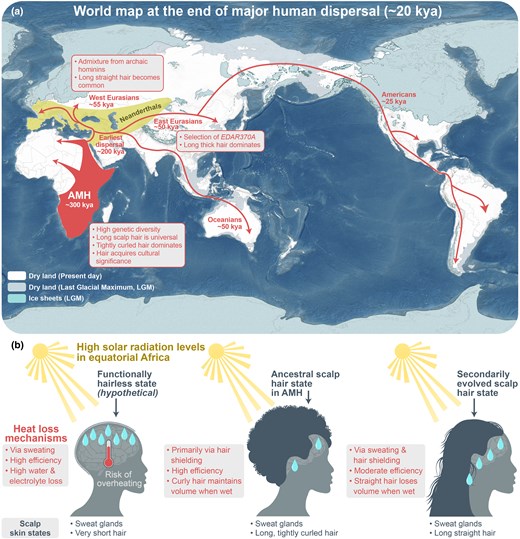2025-01-23 ペンシルベニア州立大学(PennState)
<関連情報>
- https://www.psu.edu/news/research/story/mane-attraction-molecular-switch-may-control-long-scalp-hair
- https://academic.oup.com/bjd/advance-article/doi/10.1093/bjd/ljae456/7959363?login=false
ヒトの長い頭髪の進化 Evolution of long scalp hair in humans
Lo-Yu Chang, Maksim V Plikus, Nina G Jablonski, Sung-Jan Lin
British Journal of Dermatology Published:22 January 2025
DOI:https://doi.org/10.1093/bjd/ljae456

Abstract
The ability to grow long scalp hair is a distinct human characteristic. It probably originally evolved to aid in cooling the sun-exposed head, although the genetic determinants of long hair are largely unknown. Despite ancestral variations in hair growth, long scalp hair is common to all extant human populations, which suggests its emergence before or concurrently with the emergence of anatomically modern humans (AMHs), approximately 300 000 years ago. Long scalp hair in AMHs was also a trait that was selected because it conveyed essential signals related to an individual’s age, sexual maturity, health and social status. Biologically, hair length is primarily determined by the amount of time that a hair follicle spends in the active growth phase (anagen). While anagen duration is typically tightly regulated in most mammals, the inherent ability of a hair follicle to continuously recruit new dividing progenitors to its base, where hair fibre is generated, theoretically removes limits on maximal anagen duration. We propose a model wherein hair cycle progression into and out of anagen is regulated by evolutionary malleable molecular checkpoints. Several animal species and domesticated animal breeds display long body hair, which suggests that extremely long scalp hair in humans emerged via attenuation of an existing out-of-anagen checkpoint mechanism rather than via a newly evolved molecular programme. Studying congenital and somatic mosaicism conditions featuring altered hair length could potentially unveil the currently unknown molecular basis underlying this human trait.


